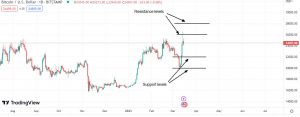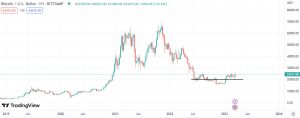
Bitcoin (BTC) skyrocketed at the beginning of this trading week, rising from $22,190 to a high of $26,533. This rally came as the prices of many cryptocurrencies began to regain their footing following the bank crisis that affected USDC, one of the largest stablecoins.
Bitcoin’s current price stands at $24,470, and despite the recent correction, bulls still control the price movement. Today, Stanko from the Crypto Lists website will discuss Bitcoin (BTC) price estimates from a technical and fundamental analysis perspective.
Please note that there are also many other factors to consider when entering a position, such as your time horizon, willingness to risk, and how much margin you have if trading with leverage.
Go directly to
- 1 The current banking crisis contributes
- 2 CPI continues the trend lower
- 3 Technical analysis for Bitcoin (BTC)
- 4 Important support & resistance levels for Bitcoin (BTC)
- 5 What speaks for the rise in the Bitcoin (BTC) price
- 6 What indicates further downfall for Bitcoin (BTC)
- 7 What do analysts and experts say?
The current banking crisis contributes
Investor sentiment improved this Tuesday drastically, and the assets in the crypto space began to regain their footing following the bank crisis. On-chain data shows that the exchange inflow of many cryptocurrencies registered its largest value in six months, and the single largest transaction, spotted by the on-chain address tracker Whale Alert, moved 11,125 BTC worth $267.95 million to Binance.
Troubles at Credit Suisse, the collapse of Silicon Valley Bank and peer Signature Bank raised hopes among investors that the U.S. Federal Reserve could announce a smaller interest rate hike or even a pause at its upcoming monetary policy committee meeting next week. Mike Novogratz, the founder of Galaxy Digital, said this week that the Federal Reserve Chair Jerome Powell would need to announce monetary easing, which could lead to a significant shift in psychology that could benefit Bitcoin and Ethereum.
Mike Novogratz also added that the current banking crisis had contributed to Bitcoin’s increased price, as it was being seen as a safe-haven asset. At the same time, the Consumer Price Index (CPI) showed this week that inflation in the United States cooled in February, which also bolstered expectations for a smaller rate hike.
Supply: 18,925,000 / 21,000,000
Release date: January 3, 2009
Description: Buy Bitcoin and revolutionize the payments space!
Risk warning: Trading, buying or selling crypto currencies is extremely risky and not for everyone. Do not risk money that you could not afford to loose.
CPI continues the trend lower
The U.S. Consumer Price Index (CPI) rose 0.4% in February from 0.5% in January, but even as CPI continues the trend lower for the eighth consecutive month now, it still is remarkably high by the Fed’s standards. The federal funds rate is now in a range of 4.5% to 4.75% (the highest level since 2007), and the main question still remains how much time Fed will need to hold policy at restrictive levels in order to fight inflation. Some analysts are warning that Fed will keep interest rates at restrictive levels for longer, and because of this, they expect a recession that could hit financial markets even more. The negative outlook for the economy by some economists make an increasing amount of people interested to try a Bitcoin casino. One of our favourite sites from the extensive toplist is Verde Casino. Verde means green in Spanish and Portuguese – perhaps it’s your lucky day?
Macroeconomist and trader Henrik Zeberg said that as long as the U.S. economy is not in a recession, the prices of Bitcoin and other cryptocurrencies will continue to be supported. For now, bulls continue to control the price movement of Bitcoin, but the highly volatile nature of the cryptocurrencies may scare investors again to sell BTC if some negative news happens in the cryptocurrency market, like a bank with large crypto exposure collapsing or a prominent crypto firm going bankrupt.
Technical analysis for Bitcoin (BTC)
Bitcoin (BTC) has advanced more than 25% since March 10, 2023, rising from $19,569 to a high of $26,533. The current price of Bitcoin (LTC) stands at $24,470, which is still more than 40% off from its 2022 highs that were registered in March. The chart below shows that Bitcoin (BTC) has been moving in a strong downtrend since November 2021, and even with the current jump, BTC remains under pressure when we look at a “bigger” picture.
Important support & resistance levels for Bitcoin (BTC)

On this chart (the period from August 2022), I marked important support and resistance levels that can help traders to understand where the price could move. The risk of decline for Bitcoin (BTC) is not over, but if the price advances again above $26,000, the next target could be located around $28,000. The important support level is $22,000, and if the price breaks this level, it would be a “SELL” signal, and we have the open way to $20,000. If the price drops below $20,000, which represents very strong support, the next target could be located around $18,000 or even below.
What speaks for the rise in the Bitcoin (BTC) price
The amount of BTC traded over the last several days saw a significant increase, and if the price advances above the resistance that stands at $28,000, the next target could be located at around $30,000. According to data from the on-chain analytics firm Santiment, whale activity surged to the highest level in four months yesterday.
The relevant indicator here is the “whale transaction count,” which measures the total amount of transfers taking place on the Bitcoin blockchain that are worth at least $1 million in value. It is also important to note that any news that gives hope that the Fed is becoming less hawkish is viewed as a positive for cryptocurrencies, and Bitcoin could advance from the current price level if the Federal Reserve increases interest rates less than analysts expect at its upcoming monetary policy committee meeting on March 21.
What indicates further downfall for Bitcoin (BTC)
The price of Bitcoin is currently trading above $24,000, but a break below this level would indicate that BTC could probably test the important support level that stands at $22,000. The highly volatile nature of cryptocurrencies may scare investors again to sell BTC if some negative news happens in the cryptocurrency market, like a bank with large crypto exposure collapsing or a prominent crypto firm going bankrupt.
What do analysts and experts say?
From a recent low of $19,569 on March 10, Bitcoin (BTC) jumped to a high of $26,533 on March 14, a 35% gain within a short time. The main question is, does it have more bullish strength left, which depends on both technical and fundamental factors. According to technical analysis, bulls still control the price movement, but on the fundamental side, there are obviously macroeconomic factors that could drag Bitcoin again below $20,000.
Despite the collapse of Silicon Valley Bank and Signature Bank, analysts warn that the U.S. central bank might raise interest rates by 25 bps this month and expect that Fed will hold interest rates at restrictive levels for a longer period. Matt Stucky, senior portfolio manager at Northwestern Mutual Wealth Management, said that this is negative for prices of stocks and cryptocurrencies, and Bitcoin might have a hard time holding above the current price levels in the upcoming weeksss.
While the rate increases are intended to tame inflation and thus help the economy, investors are worried that an aggressive interest rate policy could tip the economy into a deep recession. Macroeconomist and trader Henrik Zeberg said that as long as the U.S. economy is not in a recession, the prices of Bitcoin and other cryptocurrencies will continue to be supported.
Disclaimer: Crypto is extremely volatile and not suitable for everyone to invest in. Never speculate with money that you cannot afford to lose. The information on this site is presented for educational purposes only and should not be construed as investment or financial advice.






 Bitcoin breaches 100k USD barrier - to the moon?
Bitcoin breaches 100k USD barrier - to the moon? Transfer BTC faster than ever on Bet Panda casino
Transfer BTC faster than ever on Bet Panda casino Start off your Monday with a 1 BTC bonus at Cryptorino
Start off your Monday with a 1 BTC bonus at Cryptorino Two no-KYC casinos with bountiful BTC bonuses!
Two no-KYC casinos with bountiful BTC bonuses! Four stage 100 mBTC bonus on Power Up casino
Four stage 100 mBTC bonus on Power Up casino
























